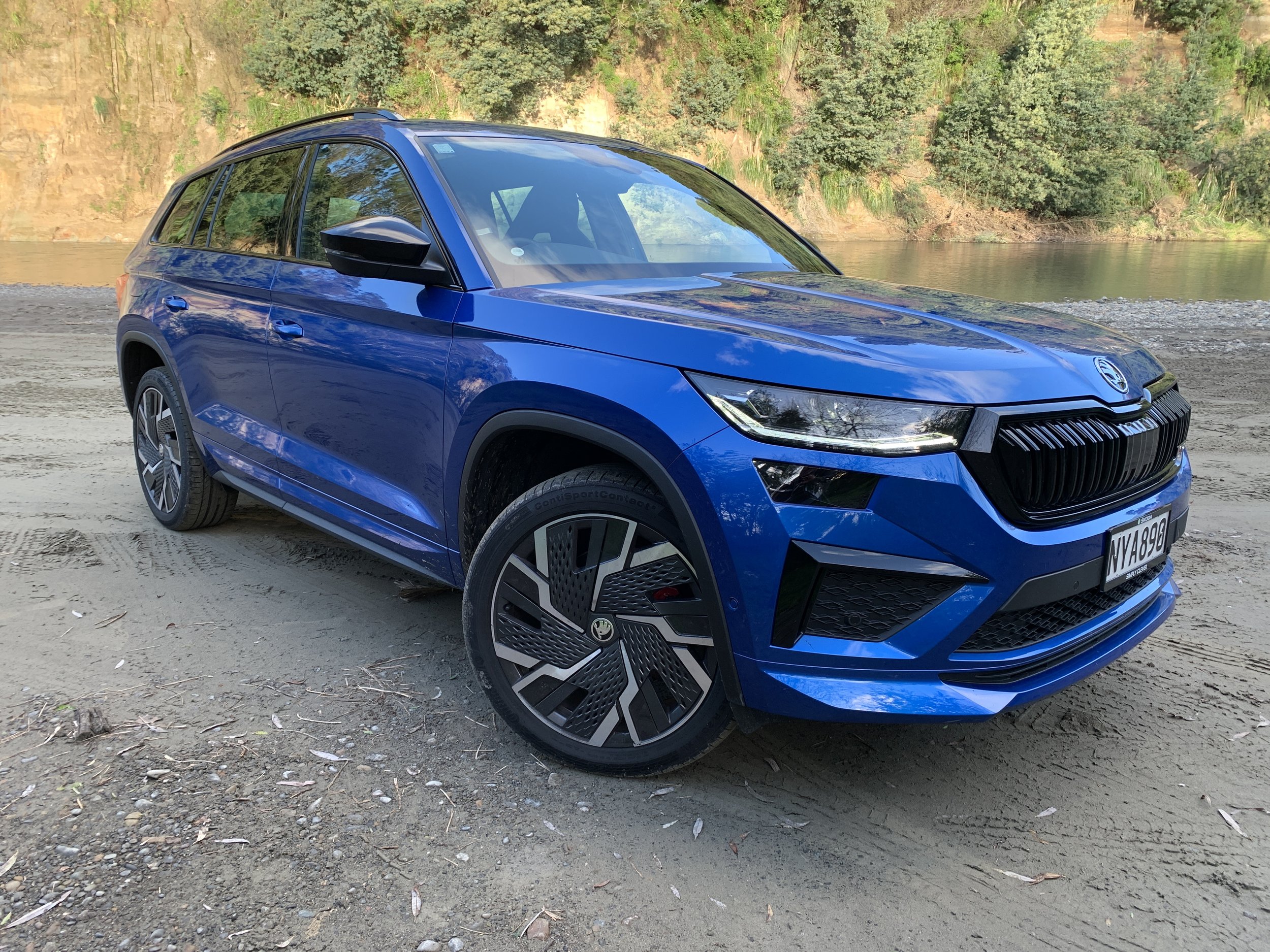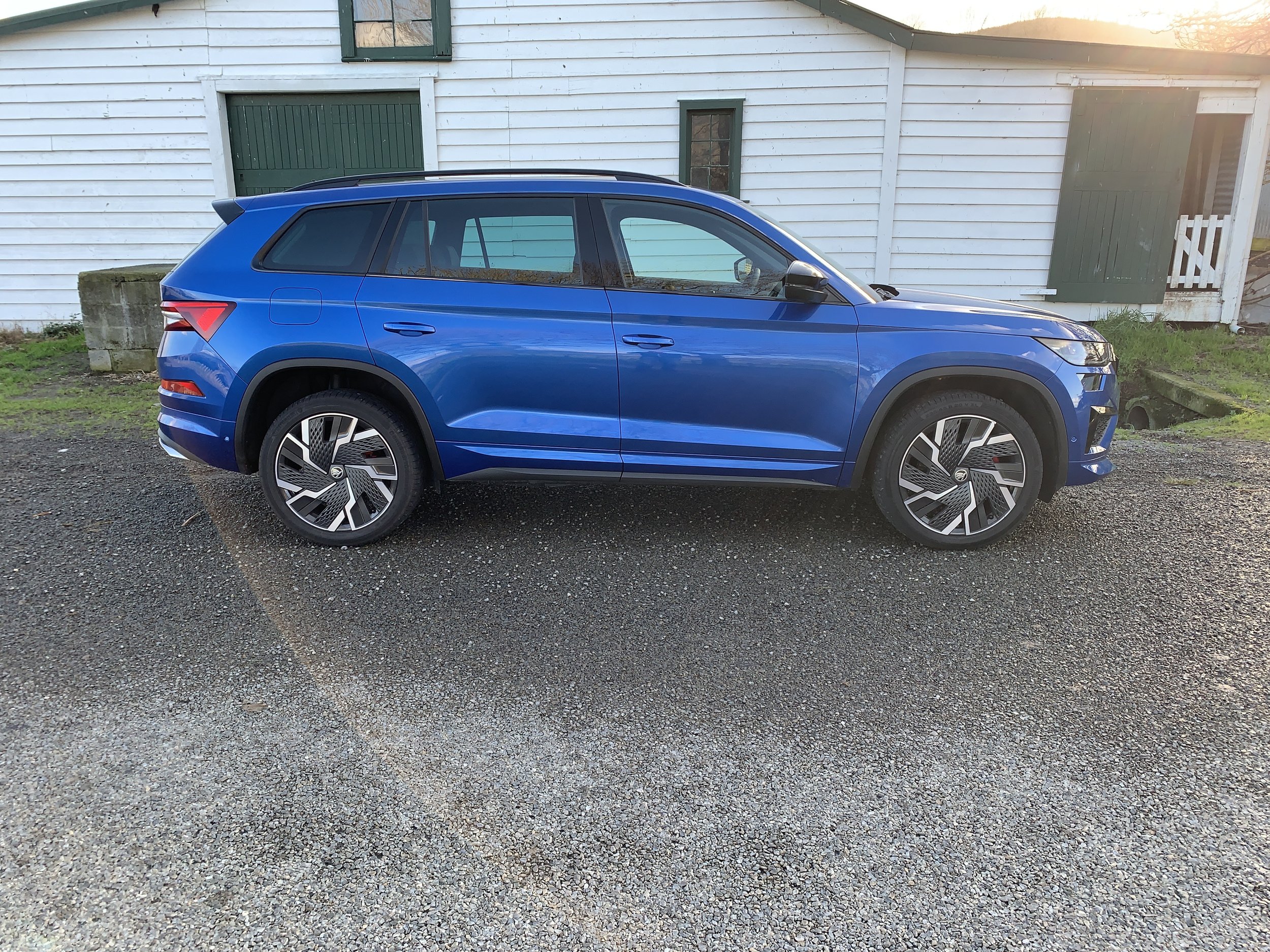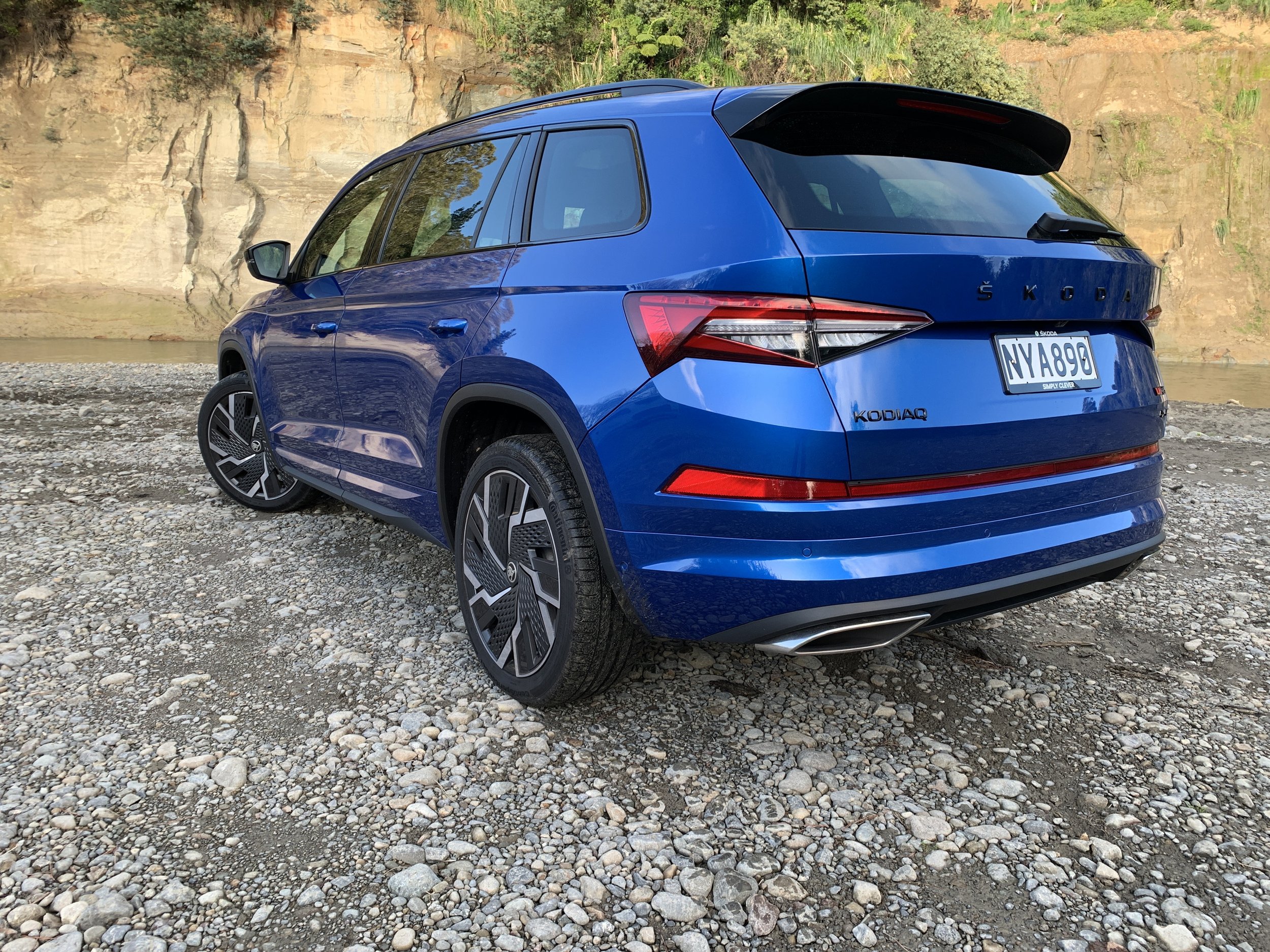Skoda Kodiaq RS roadtest review: Heart attack
/The flagship edition of this seven seat sports utility maintains as the family pace-setter, but is it as characterful after a change of engine?
Base price: $79,990
Powertrain and economy: 2.0-litre turbo-petrol inline-four, 180kW/370Nm, 7-speed dual-clutch automatic, 4WD, combined economy 8.3L/100km, CO2 190g/km.
Vital statistics: 4699mm long, 2087mm wide, 1685mm high, 2791mm wheelbase, luggage capacity 270 litres (third row up), 20-inch alloy wheels.
We like: Practical, attractive, well specified.
Not so much: Price increase, losing that diesel oomph.
POLITICALLY it was the right move because … well, Skoda’s a Volkswagen brand and ‘Dieselgate’ … yet logically it’s still challenging because … well, the price of petrol these days.
Beyond that, there’s another consideration. As enticingly involving as the Skoda Kodiaq RS now is with a performance petrol engine - the historically fabulous EA888 that has served the Group’s best hot hatches, including the Octavia RS – it’s impossible to forget how fantastic the preceding one was.
Performance turbodiesel cars are rare items; the Kodiaq RS as we knew it from 2019 until last year was all the more a slam dunk no-one saw coming. That an oil-burner, albeit one with dual turbos, could conspire to conjure all the pace and excitement that the RS badge - Skoda’s sporty, high-performance moniker - has come to signify was something particularly left field.
That it also rolled up in a family car setting with valuable currency of a Nurburgring category record – a nine minute and 29.84 second circumnavigation achieved by the late Sabine Schmitz signalled a best-ever for the seven-seater SUV sector – was all the more astounding. There are underdogs and there are ‘least likely heroes.’ This was one of the latter.
But, anyway, that variant has now gone into history; a potentially unnecessary victim of the VW Group emissions scandal and there’s nothing that can be done except for Skoda to start again.
Which it has. Not with electric as some might have hoped – because battery involvement has no place in this car - but with an engine it could easily pluck from the shelf. The EA888 runs in basically every VW Group model requiring a fast four-cylinder petrol engine.
This time there’s no Nordschleife reference to advance its pedigree, the price has climbed $8000 and it’ll need feeding more often, with every meal costing more.
The new RS is still the fleet flagship and so packs all possible fineries, plus it dresses more extrovertly than any other Kodiaq, though not outlandishly.
Even with all the additional visual cues of before - extra aero, bigger wheel rims and the usual low-profile tyres and enhanced brake rotors – it doesn’t look overly brash. I’m guessing this is Skoda protecting a brand persona that these days is carefully cultivated to deliver both sensibility and sportiness in equal balance.
Even so, does same again in style and spec also transfer to driving feel? That’s the one question that’ll trigger debate, for sure, because the powerplants could not be more different.
Against-the-clock outcome favours this new petrol. It’s faster to the posted open road limit from a standstill and overall; not by a lot – just half a second’s advantage in the 0-100kmh sprint – but enough to win the day.
The blast comes with more burn. The maker’s official figures that suggest the optimised overall drinking rate average as being 1.3 litres per 100km above the diesel’s cited 6.4L/100km is a forlorn hope in the real world. The diesel, on test two years ago, was itself a heavier consumer than claimed, but the petrol from my experience would drink it under the table. My notes from this test say 9.8L/100km.
On the other hand, when it comes to CO2 output, there’s saving from avoidance of an emissions penalty the diesel would have copped, if but by the narrowest of margins. The new mill’s cited output is just two grams per kilometre under the Clean Car cut-off. As they say, a miss is as good as a mile, but still … phew!
Everything really comes down to the powertrains’ respective feel. Divesting an engine that created 176kW and 500Nm for one that bumps up power by four kiloWatts, but drops 130Nm torque is clearly a major alteration, so it’s unsurprising difference is immediately and easily identified.
The predecessor’s hallmark was that it hit hard from the get-go and, moreover, dolloped its big surge of performance lazily, without need to rev. All thanks to its latent torque.
The petrol is a polar opposite. It delivers a crisper and more urgent response, but also demands bigger throttle inputs and more revs, because peaks in performance occur so much higher on the rev counter.
The petrol’s step-off is sharp, but it’s a totally different sensation. The speedometer shows the speed piling in, but the thump of sub-1000rpm wallop has gone and now there’s even some tyre-scrabbling (which the oiler avoided). There’s no doubting the accuracy of Skoda’s stopwatch; the petrol RS is the quicker car to 100kmh. Yet it doesn’t have that initial stompy shove any more. I miss that.
It’s a bit the same when you’re pushing along the sort of road that would suit a sporty model. Again, one is as swift as the other, but they do it differently. With the petrol, it’s very traditional GTI; point and squirt out of a corner and hard on the brakes for the next. The diesel, appreciated a different approach; one that asked for speed to be carried through bends, so it could keep it on the flow for straights. I’m not sure which I prefer, to be honest, but given this is a substantial SUV, a syrupy, more relaxed rush would probably be more in keeping with its mission. Not least when carrying passengers. That was the diesel.
If you’re a fan of a good soundtrack, the RS as it now represents is more honest, more on message. The exhaust note doesn’t sound as good here as in some Audi or VW product, but nonetheless Skoda has been quite clever in engineering the tone so that it deepens and increases depending on what drive mode you choose. The diesel RS relied far more on artificial meddling that made it more tuneful inside than out and yet still ultimately reminded that, even when diesels are augmented to sound sporty … they still sound like diesels.
There’s another element to consider as well. Along with a more freely revving engine, the overall powertrain weight this time reduces by 60kg, which surely has to benefit the handling.
The RS continues to express an additional depth to the chassis engineering over the lesser models and while it never comes across as being a total beast, it nonetheless impresses.
For a start, it gets an electrically assisted variable ratio steering setup that is very precise and coherent. Beyond that, the Kodiaq does feel lighter and a touch more agile, now. Sure, it’s not a sports car beater. Asking a large seven-seat SUV to become that would require Porsche’s involvement. But neither does it feel out of its depth when shoved along. The brake and tyre upgrades do not seem at all excessive when you punt it. Quite possibly those tyres will wear fast and be less useful for going off-seal, but let’s agree the Kodiaq isn’t exactly hard-core anyway, so maybe that’s not too much of a trade-off.
Gear shifts come as smoothly as ever thanks to the seven-speed dual-clutch DSG automatic. Selecting the Sport mode sees it hang more tenuously to each gear ratio; you can affect that by using the paddles behind the steering wheel.
In cruise, it’s best to bump the ride into Comfort mode; there’s much less road texture disruption and the car still maintains good body control. On the engine side of things, one seems as quiet as the other but, again, the petrol doesn’t seem as relaxed as the old engine.
Beyond all that, what’s also appealing about the RS is that it doesn’t divest the sensibilities that make the Kodiaq so worthwhile. While the interior is sufficiently altered to appeal to the enthusiast - with sports-style bucket seats and displays specific to intent – you get the sense it’s as robust and muck-resistant as the lesser versions’ and, clearly, just as practical in every other way as any other version.
That seven-seater provision is such a powerful attraction with SUVs and in this instance the third-row seats are quite usable and when all are filled, there is still a good amount of boot space left over. Notwithstanding, when these rearmost seats aren't in use it's worth folding them flat into the floor to create a large cargo volume of up to 835 litres, depending on the position of the adjustable middle row. There are plenty of storage areas dotted around the cabin, too.
The engine swap occurs with a mid-life update that delivers exterior changes, mainly to the front where Skoda has added a new bonnet design above a more pronounced grille, which is black and carries RS badging.
New headlights retain the split design; however, the main unit features LED Matrix technology as standard, with a daytime running light signature along the base. The result is the appearance of far slimmer headlights even though there isn't a significant difference in size.
A new lower front bumper emphasises the performance-themed nature and sets the RS further apart from the rest of the Kodiaq rage. Whereas previously the car had a broad gaping panel that spanned the front, this is now divided into three sections with gloss black inserts crowning the outer sections.
In an effort to gain efficiencies wherever possible, Skoda has introduced a 20-inch wheel design that is aerodynamically optimised and largely enclosed by plastic inserts. These attach to the alloy wheel and give it quite a distinctive appearance when stationary; I’m not sold on the look; the wheel is more attractive ‘naked’ than dressed. You can detach and stow the inserts, though that would mean sourcing wheel centres to cover the otherwise exposed hub.
Elsewhere the RS gets gloss black door mirrors, window surrounds, roof rails and badges on the rear. A larger roof spoiler continues the gloss black look and contributes to improved aerodynamics according to Skoda. The Kodiaq RS also gets LED taillights with dynamic indicators, twin exhaust pipes and a reflector strip across the full width of the car.
So it’s changed, it’s been improved and it’s different. But has it moved to a better place? That’s not an easy question to answer. The head says Skoda has done the right thing. The heart? Well, mine’s still with the RS as it used to be.






















